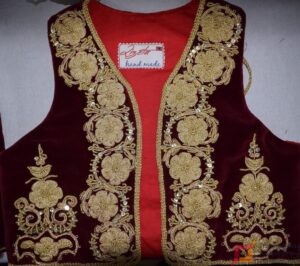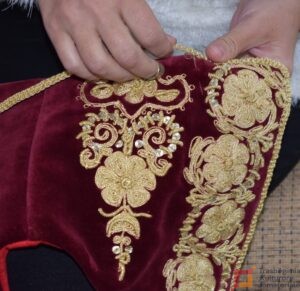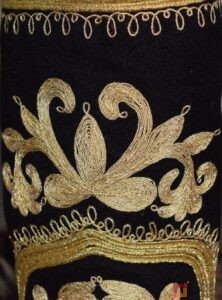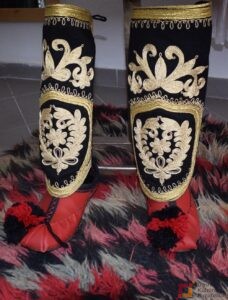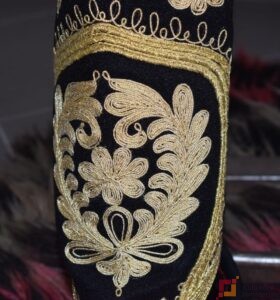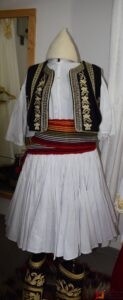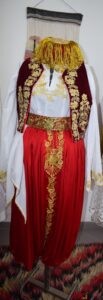The main processes to make women’s traditional costume of Gjirokastra are:
Designing the costume and motifs.
Cutting the components,
Sewing and embroidery of decorative elements.
The most beautiful and representative apparel of Gjirokastra women is the one with pirpiri as its main element. The components of this folk costume are:
Feste (kësula), is a round-shaped, about 10 cm high, and flat hat. Its color is dark cherry; a tassel fixed on the center is hanging down with some gold coins or symbols;
Wide sleeve shirts: Wide sleeves run from the shoulder down to the elbows with an embroidered circle at the end; They enhance the appearance of the clothing and show off the woman’s beauty. Its fabric is thin and transparent taffeta;
Sleeveless jelek; It comes in purple, pink, or dark cherry. A thick lining is inserted into the inside of this garment. On the front part, it features a thile (buttonhole) for fastening.
Dress or skirt. The style of this costume requires wearing a dress or a skirt; Dresses feature chest embroidery; The dress is made of almost thick light-colored fabric.
Futa is worn over the skirt or dress. Futa-të extends just as long as the skirt or dress. On the front, they are embroidered with llambro.
Shoes. Gjrokastra women wear “sheshëla” or flat shoes which consist of the sole and shoe heels; they are embroidered on the upper part. Women wear colorful woolen stockings, with rounded lines and small rosettes.
Wide sash embroidered with llambro. A wide sash is worn around the waist which is embroidered with llambro; it is attached to two buckled metal chatelaines.
Pirpiri is one of the typical Gjirokastra clothing, which is dying out. It is a traditional dress of women in Gjirokastra city. Pirpiria is the most important and expensive element from which the costume has derived its name. It makes up ¾ of this costume. It is a cape-like outer sleeveless garment, which lends an exquisite appearance to the costume. It is made from dark-colored fabric, a natural waistline, and embroidered with multiple strips. It is worked with gold thread and was usually embroidered by men. It takes several years to make one. Pispiri was worn by noble well-to-do women of Gjirokastra city.
Kondoxhup: Unlike young women, older women wear kondoxhup, which is made from a piece of dark velvet and plushy fabric along the dividing line of platforms. It is thick and lined, worn in winter to protect from the cold.
Once the costume has been designed and sewn, it is put on a dummy or something similar to check its fit, its look and to spot any possible defects.
Regarding artisanal production of sashes, necklaces, and sheshëla-s, a top priority remains to preserve their originality to the largest extent possible. Making the women’s traditional costume takes almost two months.


